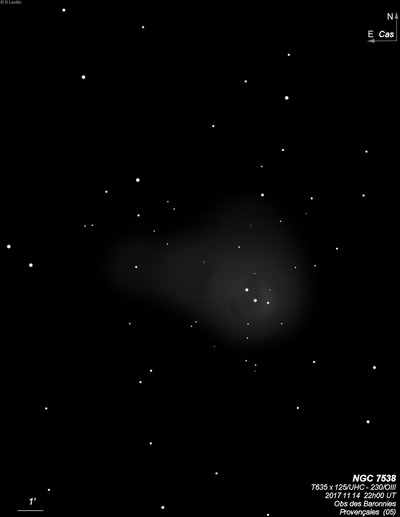
William Herschel discovered NGC 7538 = H II-706 on 3 Nov 1787 (sweep 773) and recorded "vF nebulosity of 3 or 4' extent, contains two considerable stars, but they do not seem to be connected with it." On 26 Nov 1788 (sweep 887) he noted "2 pS stars involved in nebulosity, about 2' l and 1 1/2' broad, pBM." In his 1814 PT paper WH argued that this was too unusual to be line of sight arrangement and the stars had formed within the nebula! Ralph Copeland sketched the nebula using LdR's 72" in Sep 1873 and showed two extremely faint, curved thin "tails" extending east and west.
200/250mm - 8" faint nebulosity with two mag 12 stars involved. Appears elongated and fairly large. Easy to view with averted.
400/500mm - 17.5" (8/10/91): fairly large elongated emission nebula 2.0'x0.75' oriented NW-SE. Surrounds two mag 11.5 stars oriented SW-NE (PA = 35°) with a separation of 30". The nebulosity extends SW of the pair and is brightest just west of the pair. A mag 15 star is at the SW end and a mag 14 star is 30" W of the southern mag 11.5 star. At 100x using an OIII filter the nebulosity is very bright and a fainter glow also extends east of the pair to a size of 3'x2'.
Notes by Steve Gottlieb